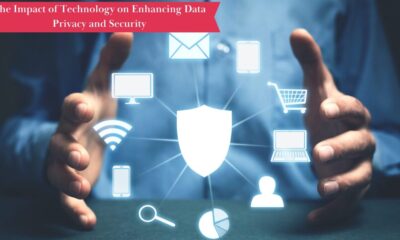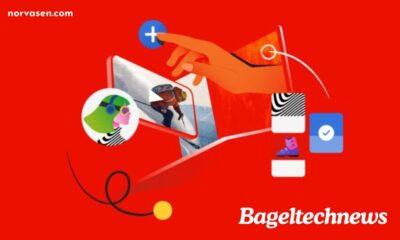Tech
Understanding the Technology Behind Hybrid Solar Inverters

In a world where renewable energy is gaining traction, hybrid solar inverters have become a crucial innovation. They focus on improving energy efficiency and reliability. These inverters are a must-have for those interested in solar power.
This blog is here to simplify the intricate technology of a hybrid solar inverter, ensuring it’s easy to grasp for all. By exploring how they work and their main benefits, you’ll understand this vital part of modern solar setups.
What Is a Hybrid Solar Inverter?
Hybrid solar inverters combine the functionalities of traditional grid-tied and off-grid inverters. Simply put, they can manage different power sources. These include solar panels, batteries, and even the electric grid.
This makes them very versatile. They ensure that you have power when you need it the most, even during outages.
How Do Hybrid Solar Inverters Work?
These inverters convert direct current from solar panels into alternating current. They go a step further by managing power from a battery backup. This means they can store excess power and draw from it when needed, ensuring energy availability around the clock.
The Role of Batteries
Batteries are critical in hybrid systems. During sunny days, excess power generated by solar panels is stored in batteries.
When the sun isn’t shining, the solar hybrid inverter draws power from these batteries, making sure your home remains powered. This is especially beneficial during blackouts or peak demand periods.
The Importance of Energy Management
One of the standout features of these inverters is their advanced energy management capabilities. They switch between power sources to optimize efficiency.
For instance, during the day, they prioritize solar power. At night, they switch to battery power, and if the battery is drained, they can draw from the grid.
Peak Shaving
Peak shaving is a criticalt function that helps manage energy usage effectively. It works by cutting back on the amount of energy taken from the grid when demand is high. Hybrid inverters, with the help of battery storage, can help you save money on your energy bills by using less energy during peak periods.
Self-Consumption
Self-consumption means using the solar power your system produces before using grid electricity. Hybrid inverters help you use more of the renewable energy you make, so you rely less on outside power sources.
Key Benefits of Hybrid Solar Inverters
Hybrid solar inverters have lots of great benefits that make them a popular choice for both homeowners and businesses.
Reliability and Efficiency
Hybrid inverters are a great choice because they use different power sources to provide you with reliable and efficient energy. They keep your power on even when the grid is down, which is a big improvement compared to regular inverters.
Cost Savings
Hybrid solar inverters may cost more at first, but they can save you money in the long run. They help lower your electricity bills by using more of the power you generate and cutting peak usage. Plus, they protect you from increasing energy expenses.
Environmental Impact
Switching to a hybrid inverter reduces your carbon footprint. By maximizing the use of renewable energy and minimizing reliance on fossil fuels, you contribute to a greener planet. This is not just good for the environment but also aligns with global efforts to combat climate change.
Types of Hybrid Solar Inverters
There are different types of hybrid solar inverters available, each suited for specific needs. Understanding these can help you make an informed choice.
All-in-One Systems
All-in-one systems integrate the solar inverter, battery inverter, and charge controller into a single unit. These are ideal for residential applications due to their compact design and ease of installation.
Modular Systems
Modular systems separate the components, offering more flexibility and scalability. These are suitable for larger installations and commercial applications where customization is key.
Backup-Only Systems
Backup-only systems focus on providing power during outages. They are less expensive but don’t offer the full range of energy management features found in other types.
How to Choose the Right Hybrid Solar Inverter
Selecting the right hybrid inverter solar can be daunting, but considering a few key factors can simplify the process.
Assess Your Energy Needs
Start by evaluating your energy consumption patterns. This includes your daily usage, peak demand times, and backup requirements. This information will help you or experts choose an inverter that meets your specific needs.
Consider Future Expansion
Think about your future energy needs as well. If you plan to expand your solar system or add more batteries, opt for a modular system that can grow with you.
Budget and ROI
While hybrid inverters are more expensive upfront, consider the long-term return on investment (ROI). Calculate potential savings on energy bills and weigh them against the initial cost to make an informed decision.
Installation and Maintenance
Proper installation and maintenance are crucial for the optimal performance of hybrid solar inverters.
Professional Installation
Always opt for professional installation, such as those offered by Blue Raven Solar in Washington, to ensure that your system is set up correctly and safely. This not only guarantees optimal performance but also extends the lifespan of your system.
Regular Maintenance
Regular maintenance checks are essential. This includes cleaning the solar panels, checking battery health, and updating the inverter’s software. Routine maintenance helps in the early detection of issues, ensuring that your system runs smoothly.
Common Misconceptions
There are several misconceptions about hybrid solar inverters that need debunking.
Too Expensive
While the upfront cost is higher, the long-term savings make hybrid solar inverters a cost-effective choice. They pay for themselves over time through reduced electricity bills and increased efficiency.
Complicated Technology
Many believe that hybrid solar inverters are too complicated to use. However, modern systems come with user-friendly interfaces and smart features that make them easy to operate.
Not Durable
Hybrid solar inverters are built to last, often coming with warranties that span several years. Proper maintenance further extends their lifespan, making them a reliable investment.
Start Your Journey to Sustainability With a Hybrid Solar Inverter Today
Hybrid solar inverters are a smart and reliable way to harness solar power. They offer continuous energy, cost savings, and help protect the environment. By understanding your energy needs and picking the right system, you can enjoy these benefits for many years.
Regular maintenance and professional installation ensure long-term efficiency. They may seem costly upfront. But, its long-term advantages make hybrid solar inverter a worthy investment.
Choose wisely and contribute to a greener, more sustainable future.
Don’t miss out on other great content! Explore our blog for a diverse range of articles on various fascinating topics. Happy reading!
Tech
6 Myths About Solar Energy Debunked

In recent years, the popularity of solar energy has skyrocketed as more homeowners recognize its potential benefits. Despite this increase in interest, many people are still held back by incorrect beliefs about solar energy.
Let’s explore six common myths surrounding this renewable energy source and the facts that debunk them in this solar installation guide.
1. Solar Energy is Too Expensive
One of the most widespread misconceptions about solar energy is that it is prohibitively expensive. While the initial investment for a solar power system can be significant, various financing options are available.
Many states also offer tax credits, rebates, and incentives that can greatly reduce costs. In fact, the long-term solar energy savings makes it one of the most energy-efficient solutions for homeowners!
2. Solar Panels Don’t Work in Cloudy Weather
Another prevalent myth is that solar panels aren’t effective unless it’s sunny all the time. While it’s true that solar panels are most efficient during direct sunlight, they can still generate energy on cloudy or rainy days.
In fact, most modern solar panels are designed to capture even diffused sunlight effectively.
3. Solar Energy Requires Too Much Maintenance
Many people think that once they install a solar power system, maintenance will be a headache. On the contrary, they are relatively low-maintenance.
Regular cleaning and occasional inspections are usually all that’s needed. Most manufacturers also provide warranties to cover any potential issues.
4. Installing Solar Panels Will Ruin Your Roof
Some homeowners fear that installing solar panels will damage their roofs. In reality, reputable solar installers know how to effectively mount panels without compromising the integrity of your roof.
Proper installation can actually improve your roof’s lifespan by protecting it from elements like UV rays and rain.
5. Solar Energy is Not Available Everywhere
While it’s true that solar energy is more effective in certain geographic locations, it is available almost everywhere. Cities and towns across the country, even in less sunny regions, are utilizing solar energy.
Innovative technology ensures that solar panels can efficiently generate power regardless of the climate. When in doubt, consult a renewable energy expert for region-specific advice.
6. Solar Panel is the Only Available Solar Energy Solution
Many people assume that solar panels are the only effective way to lower energy bills, but that isn’t true. Daylight solutions like Solatube can capture natural sunlight and channel it into interior spaces, reducing the need for artificial lighting during the day.
Visit https://thesolarguys.com/ to find out how to get started!
Don’t Let Myths Hinder Your Solar Journey!
Understanding the facts behind solar energy can empower homeowners to make informed decisions. By debunking these five myths, we can foster a clearer understanding of how solar energy can benefit us all. If you’re considering a shift to solar, take the leap and explore the options available to you!
As you plan your transition to renewable energy, consider working with experienced professionals who can guide you through the process. Don’t let misconceptions hold you back from harnessing the power of the sun.
Looking for more home improvement advice? Dive into our other blog posts for expert tips and inspiration!
READ ALSO: How to Maximise Energy with Solar Panel Cleaning Services
Tech
waxillgro279: Understanding Your Digital Identity

Did you know that the average person has over 90 online accounts? Each one requires a username, and many of those are autogenerated strings of characters you’d never choose yourself. That’s where an identifier like waxillgro279 comes in. It might look like random keyboard smashing, but it represents a much bigger story about your life online.
In this guide, we’ll pull back the curtain on these computer-generated usernames. We’ll explore what they are, why they matter for your security, and how you can manage them effectively. Let’s dive in.
What Exactly Is waxillgro279?
Before you assign any meaning to it, it’s crucial to understand that waxillgro279 is a prime example of a context-dependent identifier. In plain English, it’s a unique name created by a system, not a person.
Think of it like a digital license plate. It’s not meant to be poetic or memorable; its main job is to be unique. You might encounter a handle like this in several places:
- A new user account on a website or app.
- A temporary project ID in collaborative software.
- A transaction reference number for an online order.
- An auto-saved file name from a document editor.
The key takeaway? waxillgro279 itself has no inherent meaning. Its purpose is entirely defined by the system that generated it. You must check the source—the email, webpage, or app where you found it—to understand its true function.
A Step-by-Step Guide to Managing Autogenerated Identifiers
Finding a cryptic username in your inbox can be confusing. Here’s a simple, friendly guide to figuring out what to do with it.
- Don’t Panic or Assume. Your first reaction might be, “What is this? Is this a virus?” Remember, these identifiers are usually benign. Take a deep breath and proceed calmly.
- Verify the Source Immediately. This is the most critical step. Where did you see waxillgro279?
- Email: Check the sender’s address carefully. Is it from a company you know and trust, like Amazon, your bank, or a project management tool like Asana? Look for signs of phishing—poor grammar, urgent threats, or mismatched links.
- App or Website: Are you logged into a service? Check your account settings or notification center within the app itself. Never click on links from an unverified source.
- Understand Its Context. Once you’ve confirmed the source is legitimate, figure out the identifier’s role.
- Is it your new username for logging in?
- Is it a reference number for a customer support ticket?
- Is it a unique key for accessing a shared document?
- Decide on an Action.
- Save It: If it’s a important login ID or reference number, save it in a secure password manager or a trusted note-taking app.
- Ignore It: If it’s a temporary, one-time code, you can usually disregard it once you’ve used it.
- Change It: Many services allow you to change an autogenerated username to something more memorable in your account settings.
Why These Random Identifiers Actually Protect You
You might wonder why companies don’t just let you pick all your usernames. It seems like it would be easier! The truth is, autogenerated IDs like waxillgro279 play a huge role in modern online security.
Using a unique, random string makes it incredibly difficult for hackers to guess your login credentials through so-called “brute force” attacks. If every username was a common first name, accounts would be far less secure.
The chart below shows the relative strength of different types of usernames against automated hacking attempts. As you can see, a random alphanumeric string is significantly more robust than a common name or word.
Common Mistakes to Avoid
When dealing with these computer-assigned handles, a few missteps can cause headaches or even security risks.
- Treating It as Spam Immediately. Deleting that “welcome” email with your new user ID might mean you lose your only way to access a service you signed up for.
- Using It Across Multiple Sites. Never use the same password for waxillgro279 that you use for any other account. Its randomness is a strength, but password reuse is a critical weakness.
- Assuming All Autogenerated Messages are Safe. Scammers are clever. They know this trend and might send fake emails with similar-looking IDs. Always, always verify the source first.
Your Next Steps: Taking Control of Your Digital Self
Your online identity is a collection of these tiny data points. Managing them well is key to a secure and streamlined digital life. Here are your three key takeaways:
- Context is King. A string like waxillgro279 is meaningless without knowing where it came from. Verify the source before you do anything.
- Embrace the Randomness. These complex identifiers are a layer of security, not an inconvenience. They help keep your accounts safe from automated attacks.
- Use a Password Manager. This is the single best tool for storing these hard-to-remember usernames and generating strong, unique passwords for each of them.
What’s one change you’ll make today to better manage your digital footprints?
You May Also Read: Ovppyo: Emerging AI-Driven Automation Concept Explored
FAQs
I found “waxillgro279” in an email. Is it a virus?
Not necessarily. It is almost certainly an autogenerated username or ID from a legitimate service you signed up for. Carefully check the sender’s email address to verify it’s from a company you trust.
Can I change my autogenerated username?
In many cases, yes. Once you log into the service using the provided credentials, check your account settings or profile page. There is often an option to change your username to something more memorable.
Why do companies use such hard-to-remember names?
Primarily for uniqueness and security. Automated systems guarantee that no two users have the same ID, preventing conflicts. The randomness also makes it harder for bots to guess usernames during login attempts.
Should I be worried about privacy with these identifiers?
These IDs are typically designed to be anonymous and don’t contain personal information. However, always review the privacy policy of the service generating it to understand what data they associate with your account.
What’s the best way to keep track of them?
A dedicated password manager is highly recommended. It securely stores all your usernames, passwords, and notes, so you only need to remember one master password.
Is “waxillgro279” a product I can buy?
No. Based on its structure and common usage online, it is an identifier, not a commercial product. Be highly skeptical of any site trying to sell you something using this term.
What if I lose this username?
Use the “Forgot Username” or “Help” link on the service’s login page. You will typically need to provide the email address associated with the account, and they will send you a reminder.
Tech
FTAsiaFinance Technology: Asia’s Fintech Revolution Explained

Picture a street vendor in Manila instantly receiving payment from a tourist from Seoul using nothing but a QR code. Envision a small business in Vietnam securing a loan in minutes through an app that analyzes thousands of data points, not just a credit score. This isn’t a glimpse into a distant future; it’s the reality being built today across Asia, powered by the transformative wave of FTAsiaFinance technology.
This term is best understood not as a single company, but as a powerful label for the entire ecosystem of financial technology innovation sweeping the continent. It’s a story of digital wallets replacing cash, of AI streamlining compliance, and of blockchain creating new financial highways. At its heart, FTAsiaFinance technology is about making finance faster, more inclusive, and incredibly efficient for billions of people. Let’s dive into the engines driving this revolution.
The Core Pillars of Asia’s Fintech Transformation
The breakneck speed of financial change in Asia isn’t random. It’s being driven by a convergence of several powerful technological trends, each solving critical challenges and creating new opportunities for consumers and businesses alike.
The Digital Payments Boom: Say Goodbye to Cash
For many, the most visible face of the fintech revolution is the death of cash. Driven by ubiquitous smartphone adoption and a desire for convenience, digital and instant payments have become the default.
- Super Apps and QR Codes: Platforms like China’s Alipay and WeChat Pay, India’s PhonePe and GPay, and Southeast Asia’s Grab and Gojek have become “super apps.” Users can hail a ride, order food, pay bills, and send money to friends—all within a single ecosystem. The humble QR code is the bridge, turning any small merchant into a digital commerce node.
- Real-Time Transfers: National systems like India’s UPI and Singapore’s PayNow allow for instantaneous, 24/7 bank-to-bank transfers, making waiting for funds a thing of the past.
Mobile Wallet Adoption Growth in Southeast Asia (2002-2024)
A bar chart showing a near-vertical climb from a low base in 2020 to over 450 million users in 2024, highlighting the explosive adoption rate.
AI and Regtech: The Smart Brains Behind the Scenes
If payments are the heartbeat, artificial intelligence is the brain. AI is supercharging finance in two key ways: providing insights and managing risk.
- Credit Scoring and Lending: How do you lend to someone with no formal credit history? FTAsiaFinance technology leverages AI to analyze alternative data—phone usage patterns, utility bill payments, even social media activity—to create a financial identity for the “unbanked.” This is a game-changer for financial inclusion.
- Regulatory Technology (Regtech): For banks, complying with a maze of international and local regulations is costly and complex. AI-powered regtech tools can automate compliance checks, monitor transactions for fraud in real-time, and generate reports, saving institutions millions and making the system safer for everyone.
Open Banking and APIs: Unleashing Financial Data
Open banking is the simple but powerful idea that you own your financial data and should be able to share it securely with third-party apps to get better services. This is made possible through Application Programming Interfaces (APIs)—digital handshakes that allow different software to talk to each other.
- Imagine this: Instead of manually uploading bank statements for a mortgage application, you simply grant a lender permission to access the necessary data directly from your bank—securely and instantly. This seamless flow of information is empowering consumers and fostering a new wave of innovative financial products.
Blockchain, DeFi, and the CBDC Frontier
Perhaps the most futuristic—and debated—area of innovation lies with blockchain. While cryptocurrencies get the headlines, the underlying technology has profound implications.
- Cross-Border Payments: Traditional international money transfers are slow and expensive. Blockchain-based solutions can settle these transactions in seconds at a fraction of the cost, a huge benefit for a trade-heavy region like Asia.
- Central Bank Digital Currencies (CBDCs): Countries like China (with the digital yuan), India, and Thailand are already piloting their own sovereign digital currencies. Unlike volatile cryptocurrencies, a CBDC is digital cash issued and backed by the central bank, offering a new tool for monetary policy and financial stability.
Navigating the Regulatory Landscape
With great innovation comes the need for great responsibility. Asia’s regulators are walking a tightrope: they want to encourage the immense benefits of fintech while protecting consumers and ensuring financial stability. The approach varies widely.
- Sandbox Environments: Many countries, like Singapore and Hong Kong, have created “regulatory sandboxes.” This allows fintech startups to test new products in a controlled environment with real customers, without immediately facing the full burden of financial regulations.
- Balancing Act: The key challenge is finding the right balance. Too much regulation too soon can stifle innovation. Too little can lead to consumer harm and systemic risk. The ongoing evolution of this regulatory context is a critical part of the FTAsiaFinance technology story.
3 Actionable Tips to Leverage This Fintech Wave Today
This isn’t just abstract news; it’s a shift you can benefit from right now.
- Embrace a Digital Wallet: If you haven’t already, download a reputable digital wallet or payment app common in your country. Link it to your bank account and use it for small, daily transactions. Experience the convenience firsthand.
- Explore Personal Finance Apps: Use open banking to your advantage. Connect your accounts to a budgeting app that gives you a unified view of your finances, helping you track spending and save more effectively.
- Stay Curiously Informed: The fintech space moves fast. Follow a few reputable tech or finance news sources focused on Asia. Understanding these trends can help you make smarter financial decisions and even spot new career opportunities.
The story of FTAsiaFinance technology is still being written. It’s a collaborative effort between visionary startups, forward-thinking banks, and adaptable regulators, all focused on building a financial system that works for everyone. The transformation is profound, and it’s happening right now.
What aspect of Asia’s fintech revolution excites or concerns you the most? Have you had a personal experience with these technologies? Share your thoughts and stories in the comments below!
You May Also Read: Ovppyo: Emerging AI-Driven Automation Concept Explored
FAQs
Is FTAsiaFinance technology a specific company I can invest in?
No, it is not a single company. It’s an umbrella term used to describe the broad ecosystem of financial technology innovations and companies focused on the Asian market.
Are digital wallets and super apps safe to use?
Reputable apps employ bank-level security, including encryption and two-factor authentication (2FA). However, always practice good digital hygiene: use strong passwords, never share your OTPs, and only download apps from official stores.
What is the biggest barrier to fintech adoption in Asia?
While adoption is high, challenges remain. These include the digital divide between urban and rural areas, concerns over data privacy, and the complexity of creating harmonized regulations across different countries.
How is AI in fintech different from traditional banking software?
Traditional software follows predefined rules. AI and machine learning can learn from data, identify patterns, and make predictions or decisions without being explicitly programmed for every scenario, making it far more adaptive and powerful.
Will CBDCs replace cash completely?
It’s unlikely in the near future. Most central banks view CBDCs as a complement to cash, not a replacement. They aim to provide a secure, digital alternative for those who want it while ensuring cash remains available.
How does open banking benefit me if I’m not a tech expert?
You don’t need to be an expert! The benefits come through the apps you use. You’ll get easier account switching, personalized financial advice, and faster loan approvals because apps can securely access the data they need with your permission.
What’s the next big trend in Asian fintech?
“Embedded finance” is a major frontier. This is where financial services are seamlessly integrated into non-financial apps—like buying insurance at the click of a button when booking a flight or getting a point-of-sale loan at an online checkout.
-

 Education9 months ago
Education9 months agoMastering Excel: Your Comprehensive Guide To Spreadsheets And Data Analysis
-

 Tech12 months ago
Tech12 months agoHow To Choose The Best Forex Trading Broker?
-

 Business1 year ago
Business1 year agoExploring the Rental Market: Properties for Rent in Malta
-

 Blog9 months ago
Blog9 months agoArab MMA Fighters Shine Bright: Meet the Champions of PFL MENA
-

 Travel1 year ago
Travel1 year agoExperience the Best Desert Safari Dubai Offers!
-

 How-To Guides1 year ago
How-To Guides1 year agoComprehensive Guide to Cockwarming: Enhancing Intimacy and Connection
-

 Home Improvement1 year ago
Home Improvement1 year agoEco-Friendly Round Rug Options for Sustainable Living in NZ
-

 Apps and Games1 year ago
Apps and Games1 year agoDiscover Tickzoo: The Ultimate Platform for Video Content Lovers and Creators












